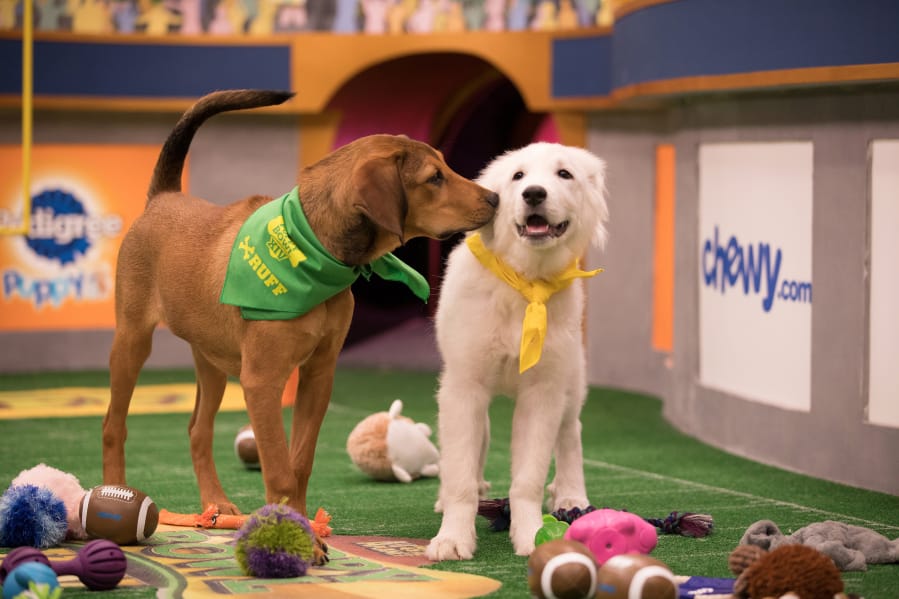It’s Game Day. A player steps onto the field, ready to face off in a ferocious contest of strength, agility and mental focus. Millions of passionate viewers in living rooms across the country have gathered to watch him compete in one of the year’s most anticipated, uniquely American TV events. The weight of expectation — from fans, teammates and sponsors alike — is almost palpable in the air.
But Mr. Wigglesworth would rather be taking a nap.
A shar-pei with a coat of downy white fur, a pale pink nose and a wrinkled, jowly face, Mr. Wigglesworth is one of the 90 puppies who’ve traveled from far and wide to compete in “Puppy Bowl XIV,” airing on Animal Planet a few hours before that other big game kicks off on Sunday. Perhaps exhausted by his journey to New York City from Florida, the 15-week-old ignores the squeaky toys and stuffed animals strewn across the 25-foot playing field and promptly falls asleep on the sideline.
“I’ve got to call a penalty,” declares referee Dan Schachner as a camera zooms in on the dozing puppy. “Excessive snoozing.”
First broadcast 13 years ago, the “Puppy Bowl” has morphed from a novelty counterprogramming experiment into must-see television for dog enthusiasts, the football-averse and those who just can’t resist a good animal pun. A major ratings draw and social media magnet, the event promotes pet adoption — all the “players” are nonprofessionals from 48 shelters around the country.
Despite its popularity, the vast majority of “Puppy Bowl” devotees probably have little idea of the intense effort behind producing the two-hour show and crafting a story around the unpredictable participants.
“The challenging part is you just can’t produce animals like people,” explains Simon Morris, the showrunner of “Puppy Bowl” for the past three years. He previously worked with more complicated two-legged subjects on shows like Bravo’s “Real Housewives of Atlanta” spinoff “Don’t Be Tardy” and appreciates that puppies are, by comparison, drama-free.
That’s also the problem, says Morris, a former dachshund owner who is currently dog-less.
“All we can really do is put the puppies on the field, leave some toys there and cover it with lots of camera angles,” he says.
As a dramatist, Morris admits he slightly prefers dogs to cats: “Filming-wise, they give you a little bit more.”
The creative process begins in the summer, when producers reach out to shelters in search of puppies who will be 12 to 22 weeks old when the game films in October (spoiler alert: It’s not live). The goal is not just to get a wide range of sizes and breeds but to draw from as many shelters in as many states as possible.
This year’s recruits come from 26 states and include the competition’s first-ever international puppy — Mango, a Chihuahua/American Staffordshire terrier mix from Mexico. Also playing are two special-needs puppies: Buttons, a deaf and blind cocker spaniel, and Sophie, a three-legged goldendoodle.
Last year, the “Puppy Bowl” in its initial broadcast attracted 2.5 million viewers, making it the most-watched cable broadcast of the day. Its success has even inspired copycat events — pun intended — such as the Hallmark Channel’s “Kitten Bowl” and National Geographic’s “Fish Bowl.”
In the Big Apple, the puppies “publicize” the event, posing for photos and meeting with social media and marketing teams. A studio is transformed into a makeshift green room where the puppies wait in pens lined with wee-wee pads until it’s their turn to play.
As the show has grown in popularity and evolved from pop culture curiosity into cherished tradition, producers continue to look for new ways to up the ante. This year’s game will be played in a new “stadium” and include barnyard animal cheerleaders, a sloth referee and a kitty halftime show inspired by Justin Timberlake. The first ever “Dog Bowl,” featuring mature canines in need of homes, will air on Saturday.
Morris plots seemingly inconsequential yet critical details — like where to find toys small enough for the littlest puppies to pick up with their mouths. The action is captured by a dozen or so cameras, placed on the end of sticks coated in peanut butter (“lick cams”) underneath glass water bowls and in the end zone to catch every touchdown and field goal.
During the four-day shoot, which will produce 100 or so hours of footage, Morris and his associates, including director Richie Wirth, watch the action via a wall of monitors in the control room. They sometimes feed lines to Shachner, the referee, who hands out penalties for infractions such as “unnecessary ruff-ness.”
Mr. Wigglesworth is already showing breakout potential. When the puppy suddenly awakens, charges down the field and almost scores a touchdown, a chant erupts in the control room: “Wigg-les-worth! Wigg-les-worth!” A minute later, Morris is asking Wirth to get a group shot of the puppies but stops midsentence as he spots the kind of action that will definitively not take place in the Super Bowl.
“Oh, no,” he says. “Mr. Wigglesworth is doing a (poop) on the end zone.”
And just like that, a star is born.




